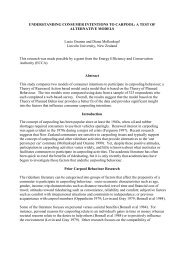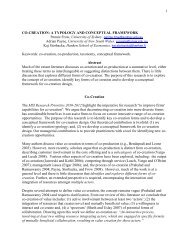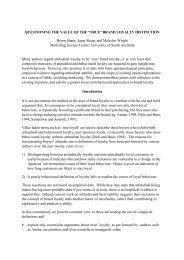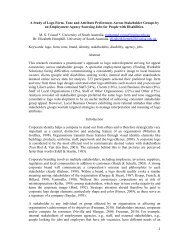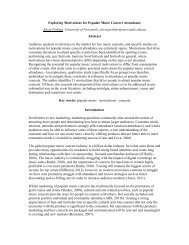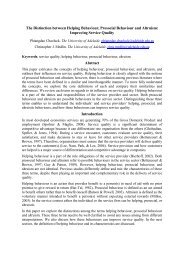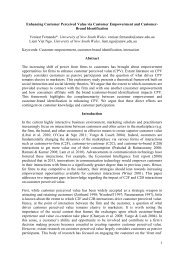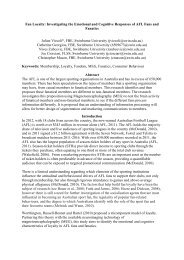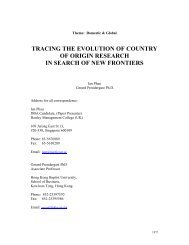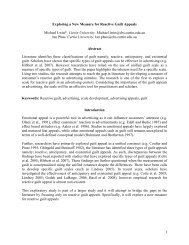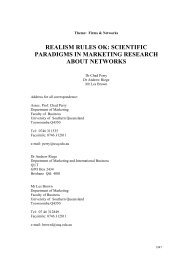1 Evidence that Loyalty is a Natural Behaviour Marianthi ... - ANZMAC
1 Evidence that Loyalty is a Natural Behaviour Marianthi ... - ANZMAC
1 Evidence that Loyalty is a Natural Behaviour Marianthi ... - ANZMAC
Create successful ePaper yourself
Turn your PDF publications into a flip-book with our unique Google optimized e-Paper software.
<strong>Evidence</strong> <strong>that</strong> <strong>Loyalty</strong> <strong>is</strong> a <strong>Natural</strong> <strong>Behaviour</strong><br />
<strong>Marianthi</strong> Livadit<strong>is</strong>*, Byron Sharp and Anne Sharp, Ehrenberg-Bass Institute, UniSA<br />
Abstract<br />
Traditionally ‘loyal’ behaviour <strong>is</strong> viewed as something <strong>that</strong> must be earned (or bought) by<br />
marketers, i.e. a consequence of marketing actions (e.g. differentiation, service quality) and<br />
consumers’ subsequent attitudinal preferences for particular brands. Yet loyalty <strong>is</strong> one of the<br />
most prevalent, marked character<strong>is</strong>tics of consumer behaviour. Instead of buying randomly,<br />
consumers show biased behavioural preferences, repeat-purchasing some brands over others.<br />
An alternative view <strong>is</strong> <strong>that</strong> loyalty <strong>is</strong> a natural human tendency in choice situations. In support<br />
of th<strong>is</strong> view, th<strong>is</strong> paper reviews a broad range of empirical evidence and the accompanying<br />
psychological explanations.<br />
Introduction<br />
The !Kung San of the Kalahari Desert in southern Africa believe <strong>that</strong> babies must be taught to<br />
sit, <strong>that</strong> it does not come naturally. They prop piles of dirt around babies to push them into a<br />
sitting position. Other cultures find th<strong>is</strong> amusing; similarly many cultures find it equally<br />
amusing when Westerners talk to babies, often in ‘baby talk’, in the belief <strong>that</strong> babies can<br />
somehow understand such sentences and must be spoken to in order to stimulate their own<br />
speaking. Pinker (1994) points out <strong>that</strong> learning language, like learning to sit, comes naturally<br />
- we have a natural d<strong>is</strong>position (presumably underpinned by genetics). Th<strong>is</strong> paper proposes<br />
<strong>that</strong> the bias in behavioural preferences, or ‘loyalty’, shown to brands <strong>is</strong> also a natural<br />
d<strong>is</strong>position for consumers, rather than the result of marketing efforts building attitudes.<br />
Brand loyalty has traditionally been portrayed as an outcome of marketing strategy, <strong>that</strong> it <strong>is</strong><br />
something <strong>that</strong> must be earned (or bought) and will erode if a brand slips in its differentiation,<br />
value, and/or service quality. It <strong>is</strong> still common for marketers to think loyalty requires<br />
substantial encouragement. Consumers are portrayed as jealously guarding their loyalty as a<br />
prize they give away rarely. In complete contrast loyalty has recently been referred to as<br />
‘innate’ (Sharp and Newstead 2010); as an ‘intrinsic’ behaviour, inherent to consumers and<br />
not to the brand or product itself (Keaveney, 2011; Sharp, 2010); <strong>that</strong> advert<strong>is</strong>ing may not be<br />
needed to develop brand loyalty (Ehrenberg and Charlton 1973); <strong>that</strong> preferences develop<br />
despite product and brand homogeneity (e.g. Chapman et al. 2006; Charlton and Ehrenberg<br />
1973; McConnell 1968; Tucker 1964); and <strong>that</strong> loyal behaviour <strong>is</strong> most likely a habitual<br />
response to reduce dec<strong>is</strong>ion-making effort (e.g. Quester and Lim 2003; Uncles et al. 2003).<br />
Despite th<strong>is</strong> growing trend, the literature <strong>is</strong> scattered, largely suggestive and relatively ignored<br />
or contrasted by other widely read literature (e.g. Clarke 2001; McAl<strong>is</strong>ter 1982). In th<strong>is</strong> paper<br />
we carry th<strong>is</strong> new thinking forward towards conceptualizing brand loyalty as consequence of<br />
a strong natural behavioural tendency, i.e. <strong>that</strong> it comes naturally.<br />
Despite knowledge of consumer loyalty having evolved over time, current literature still fails<br />
to describe loyal behaviour as a natural tendency. The past few years have seen a burgeoning<br />
interest in consumers’ love for brands (e.g. Albert, Merunka, and Valette-Florence 2008).<br />
Batra et al. (2011) describe brand loyalty as a consequence of ‘brand love’. Others claim <strong>that</strong><br />
arousal and pleasure, i.e. truly ‘delighting’ consumers, will lead to brand loyalty (Bowden et<br />
al., 2009; Oliver, Rust and Varki, 1997). Th<strong>is</strong> signifies a problematic juxtaposition in the<br />
literature. Given th<strong>is</strong>, it <strong>is</strong> essential to put a spotlight on the potential inherency of brand loyal<br />
behaviour.<br />
1
In th<strong>is</strong> paper we outline general<strong>is</strong>able laws and empirical findings in marketing illustrating<br />
<strong>that</strong> loyalty <strong>is</strong> regular and predictable and everywhere. We then explore a broad range of<br />
specific examples where loyalty has been found to occur, even in the absence of marketing<br />
efforts, including observational findings <strong>that</strong> reinforce and exemplify the ubiquitous nature of<br />
loyalty. Finally, th<strong>is</strong> paper briefly offers supporting psychological explanations for the<br />
observed biased consumer behaviour, which centre on the notion <strong>that</strong> it <strong>is</strong> employed to reduce<br />
efforts and r<strong>is</strong>ks associated with making dec<strong>is</strong>ions, even high involvement dec<strong>is</strong>ions.<br />
<strong>Loyalty</strong> in all Markets<br />
<strong>Loyalty</strong> has customarily been thought of as something <strong>that</strong> must be won or earned, <strong>that</strong> it<br />
needs special conditions for it to occur, e.g. <strong>that</strong> the consumer has to perceive a meaningful<br />
difference between the brand and rivals (e.g. see Aaker, 2001). The concept of a loyalty<br />
ladder - to progress a customer along a continuum from prospective client to advocate of a<br />
brand - <strong>is</strong> evidence of th<strong>is</strong> line of thinking (Uncles, Dowling, Hammond, 2003).<br />
Yet, brand loyalty appears to be a character<strong>is</strong>tic of every market (Sharp, 2010). Consumers<br />
exhibit loyal/biased behaviour to brands, services, stores, product categories and activities<br />
(Uncles, Dowling, Hammond, 2003). They tend towards polygamous loyalty. Consumers<br />
could switch more than they do, but as Ehrenberg, Uncles and Goodhardt (2004) clarify<br />
‘having small habitual brand repertoires requires less mental effort than continually switching<br />
brands, yet enables consumers to exerc<strong>is</strong>e choice without having to re-evaluate all the<br />
available criteria’. An example of th<strong>is</strong> <strong>is</strong> car buying. When considering the large number of<br />
car brands to choose from - there are over 60 - one might expect car-buyers, who typically<br />
buy years apart might be prone to less loyalty and more brand switching. However, almost<br />
half the time new car buyers buy the same brand as they bought last time (Lapersonne,<br />
Laurent, Le Goff, 1995) and consider only two brands on average (Dawes, Mundt, Sharp,<br />
2009; Sharp, 2010).<br />
Marketing science has shown <strong>that</strong> loyalty metrics do not vary idiosyncratically between rival<br />
brands, but are instead regular and predictable. Certainly loyalty <strong>is</strong> very prevalent, consumers<br />
seldom buy randomly, but instead show biased behaviour preferences, favouring some brands<br />
over others. Patterns of individual loyalty underpin regularities in aggregate brand loyalty<br />
metrics in many, if not all, markets; from soap to soup to soap operas (Ehrenberg, Uncles,<br />
Goodhardt, 2004; Sharp, 2010). Th<strong>is</strong> <strong>is</strong> evidenced by the empirical law, Double Jeopardy,<br />
which shows large and small (rival) brands differ substantially in how many people buy them,<br />
but often hardly differ in terms of how loyal their buyers are to them (Ehrenberg, Goodhardt<br />
and Barw<strong>is</strong>e, 1990). Ultimately then, every brand gets its share of loyal customers, seldom<br />
much more or less. Th<strong>is</strong> logically suggests <strong>that</strong> individual consumers have a tendency for<br />
loyalty, rather than needing special conditions brought about by marketing efforts.<br />
If loyalty has to be earned then new brands should have very low loyalty. Yet a landmark<br />
study of 20 new brands and brand extensions of frequently bought consumer goods (e.g.<br />
coffee, toothpaste and anti-depressants) found <strong>that</strong> normal loyalty measures developed almost<br />
instantly (Ehrenberg and Goodhardt, 2000). A successful new brand’s average purchase rate<br />
(how often buyers bought it in the analys<strong>is</strong> period) was at or near subsequent “normal” level<br />
and also equal to the rates for establ<strong>is</strong>hed brands, virtually from the start (Ehrenberg and<br />
Goodhardt, 2000). Furthermore, a near simultaneous d<strong>is</strong>covery of ‘near-instant loyalty’ was<br />
found for an unsuccessful new brand launch (Wright and Sharp, 2001). Th<strong>is</strong> further suggests<br />
<strong>that</strong> bias consumer behaviour <strong>is</strong> not earned, but rather a character<strong>is</strong>tic of all brands, even<br />
2
unsuccessful ones; it happens naturally and in the absence of any specific marketing effort.<br />
If loyalty depended on conditions brought about by appropriate marketing it should be<br />
expected <strong>that</strong> loyalty strategies in particular would substantially drive up loyalty. In line with<br />
th<strong>is</strong> thinking, Reichheld and Sasser (1990) said <strong>that</strong> it was perfectly possible for a brand to<br />
double its loyalty for very low cost simply by concentrating on loyalty marketing (an<br />
argument d<strong>is</strong>puted by Sharp 2010). Yet evidence has since shown loyalty programs have an<br />
underwhelming effect on increasing repeat-purchase (i.e. loyalty) behaviour (Meyer-Waarden,<br />
2006; Leenheer, 2007; Sharp and Sharp, 1997).<br />
If loyalty depends so heavily on marketing creating the right conditions then some brands<br />
should be loyalty superstars and some completely bereft of loyalty. Despite novel stories of<br />
brands succeeding due to the exceptional and ‘unreasonable' loyalty of their customers (e.g.<br />
Harley Davidson, Apple, ‘Lovemarks’ (Roberts, 2004)), the empirical evidence does not<br />
support these claims (see Sharp, 2010). For example, Nike <strong>is</strong> said to have a strong brand<br />
personality and according to Roberts (2004) earns the tile of ‘Lovemark’ - a brand inspiring<br />
‘loyalty beyond all reason’ (cited in Dawes, 2009). Hence Nike should be a sports label<br />
superstar but as Dawes (2009) demonstrated sportswear also conforms to empirical<br />
regularities of brand loyalty; namely <strong>that</strong> sportswear brands - such as Nike, Adidas, Fila,<br />
Umbro, Puma - differ in the loyalty of their customers but only in relation to their size<br />
(market share) and Nike does not dramatically outperform these other brands.<br />
<strong>Loyalty</strong> in Largely Marketing Free Environments<br />
As d<strong>is</strong>cussed previously the traditional marketing theory <strong>is</strong> <strong>that</strong> loyalty depends on consumers<br />
perceiving meaningful differences between brands such <strong>that</strong> they form attitudinal preferences,<br />
which shape their buying behaviour, making them loyal. Thus there can be no loyalty in<br />
‘commodity markets’ where all products are much the same or identical. Marketing then,<br />
often takes credit for loyalty. Yet loyal behaviour emerges, and quickly, in environments<br />
where there <strong>is</strong> no differences between the brands, no advert<strong>is</strong>ing, no physical availability<br />
differences, and no brand image.<br />
Tucker (1964), and subsequently McConnell (1968) both d<strong>is</strong>covered consumers quickly<br />
developed loyalties even when products were identical and brand names effectively<br />
meaningless (e.g. letter labels L, M, P) for both bread and beer respectively. Throughout each<br />
experiment participants gave statements (sometimes quite passionate) reasoning why one<br />
brand was better or worse than another. Even in the absence of d<strong>is</strong>tingu<strong>is</strong>hing features or taste<br />
people were inclined to select only one brand to habitually buy or at the very least reduce<br />
their options by eliminating one from consideration, or choosing between only two. With the<br />
exception of Charlton and Ehrenberg (1973, 1976) and Ehrenberg and Charlton (1973), these<br />
experiments appear to have been lost in the literature, having received virtually no mention or<br />
empirical follow-up in over 30 years.<br />
With a continued interest in extending Tucker (1964) and McConnell’s (1968) findings,<br />
Ehrenberg and Charlton (1973) conducted a study selling identical washing powder, using<br />
letter codes as ‘brands’. It was found brand loyalty developed despite a lack of advert<strong>is</strong>ing<br />
proving such activity might not be needed to develop it. A follow-up study (Charlton and<br />
Ehrenberg, 1976) again using identical product, detergent and leaf tea labelled with a letter or<br />
number, again revealed the development of normal patterns of brand loyalty. Even marketing<br />
inputs (a promotion, advert<strong>is</strong>ing, an out-of-stock condition, and the introduction of a new<br />
3
and) produced a d<strong>is</strong>tinct lack of after-effects.<br />
When physically identical stimuli were presented to respondents over separate studies<br />
spanning samples of milk, colour, potato chips and cottage cheese, the proportion <strong>that</strong> felt<br />
they had a preference was cons<strong>is</strong>tently 70% (Chapman, Grace-Martin and Lawless, 2006;<br />
Chapman and Lawless, 2005; March<strong>is</strong>ano et al., 2003). Attempts to manipulate the other 30%<br />
of ‘no preference’ responses have had little effect and the tendency of subjects to respond<br />
with what has been called ‘false-alarm’ remains remarkably cons<strong>is</strong>tent and stable. Although<br />
plausible explanations have been offered, such as perception of momentary differences and<br />
failure to notice or believe in the ind<strong>is</strong>tingu<strong>is</strong>hable quality of the samples, none can fully<br />
explain th<strong>is</strong> 70% bias to choose one identical sample over another (Chapman, Grace-Martin<br />
and Lawless, 2006).<br />
Other behaviours suggest loyalty <strong>is</strong> a mechan<strong>is</strong>m used to shortcut dec<strong>is</strong>ion-making,<br />
particularly when faced with selecting between many near-identical alternatives. A study<br />
(Sundar, 2004) observing students using campus computer terminals revealed users were<br />
loyal to one or more favoured computer terminals despite there being over 62 available<br />
computers. Biased behaviour even appears in our everyday and seemingly thoughtless<br />
actions. Places where it has been observed (mostly anecdotal) and suggested to occur are;<br />
communal gym lockers, lecture theatre and classroom seating, the route chosen to walk to<br />
work, websites v<strong>is</strong>ited and even the types of meals consumed. These biased behaviours<br />
emerge in the face of other perfectly interchangeable alternatives, and often in spite of<br />
wanting change or variety. There appears to be much evidence to support the notion <strong>that</strong><br />
many things are done primarily out of habit often based on automatic biases, although we are<br />
rarely conscious of these habits.<br />
Psychological Explanations for Loyal <strong>Behaviour</strong><br />
In a recent article for Admap, John Keaveney (2011) made the point <strong>that</strong> there are people who<br />
are pred<strong>is</strong>posed to be loyal; <strong>that</strong> brand loyalty originates from a person’s heart and <strong>is</strong><br />
‘natural’. Empirical data shows <strong>that</strong> those who claim to be more d<strong>is</strong>loyal to brands are more<br />
experimental by nature. Those who prefer casual relationships are 76% more likely to not<br />
stick with any one brand. Nice people tend to be more loyal to brands and those who don’t try<br />
to be nice to other people are 40% less likely to be brand loyal. Keaveney (2011) deduces <strong>that</strong><br />
the ‘core source of true brand loyalty comes from the inside of a person, rather than external<br />
marketing factors’, <strong>that</strong> it <strong>is</strong> our emotional core <strong>that</strong> dictates our relationships and brand<br />
connections.<br />
A possible explanation for brand loyalty <strong>is</strong> a natural tendency toward habitual behaviour.<br />
Habit has been considered as a possible driver of buying behaviour (Engel, Blackwell and<br />
Miniard, 1993; Kaas, 1982). Whilst our habits often go unnoticed, consumer behaviour<br />
reveals intentional split-loyalty. In many survey elicited responses, respondents over-defend<br />
their (largely unconscious) dec<strong>is</strong>ions and create ‘back-stories’ and justifications. Often, the<br />
simple act of asking makes the consumer assume the dec<strong>is</strong>ion was made consciously (N<strong>is</strong>bett<br />
and Wilson, 1977). Habits make us cognitively efficient and are said to control 95% of our<br />
behaviour (Lakoff and Johnson, 1999). Social psycholog<strong>is</strong>t Wendy Wood conducted an<br />
experiment prompting participants to record where they were and what they were doing at<br />
random intervals and found rather profoundly ‘almost half the time most of what we do <strong>is</strong><br />
what we do most of the time’ (Townsend and Bever, 2001; Wood, Quinn and Kashy, 2002).<br />
4
Some research has suggested different psychological explanations for different types of<br />
purchases i.e., inertia and habit explain low involvement purchases whereas more cognitive<br />
effort applies to high-involvement purchases (Jensen and Hansen, 2006). However, as<br />
illustrated thus far, loyalty <strong>is</strong> a behaviour represented across a plethora of category and<br />
purchase types, and regardless of purchase involvement consumers time and time again<br />
reduce their selection to a mere few and often select repetitively and cons<strong>is</strong>tently from small<br />
consideration sets. These findings suggest a universal character<strong>is</strong>tic of bias behaviour <strong>that</strong><br />
implies we desire less cognitive involvement and are potentially “lazy” when it comes to<br />
purchase dec<strong>is</strong>ions. Alternatively, habits allow us to make routine dec<strong>is</strong>ions more efficiently<br />
leaving us more time for important things like family, work and social activities.<br />
Confirmation bias theory offers another possible psychological explanation for why people<br />
form loyalties; based on the idea <strong>that</strong> we see what we are looking for and collect evidence to<br />
help us see ‘signs’ <strong>that</strong> we have, or are about to, make the right dec<strong>is</strong>ion. The overall picture<br />
from among th<strong>is</strong> literature <strong>is</strong> <strong>that</strong> there <strong>is</strong> a general tendency for people to believe too much in<br />
their favoured hypothes<strong>is</strong> (Jones and Sugden, 2001; Klayman, 1995; Nickerson, 1998). Th<strong>is</strong><br />
may explain why participants in McConnell’s experiment swore <strong>that</strong> one beer tasted better<br />
despite their sameness.<br />
A likely and favourable explanation for the tendency to bias behaviour <strong>is</strong> to ass<strong>is</strong>t in the<br />
reduction of thinking, searching time and effort. <strong>Natural</strong>ly, thinking time <strong>is</strong> reduced when<br />
consumers are able to make dec<strong>is</strong>ions more quickly owing to “knowing” which brand they are<br />
going to choose. Brand image and awareness have been shown as heur<strong>is</strong>tics used by<br />
consumers to reduce r<strong>is</strong>k and dec<strong>is</strong>ion-making time (Sheth and Venkatesan, 1968). Simple<br />
heur<strong>is</strong>tics (e.g. price, packaging) are used by consumers to make efficient and reliable<br />
dec<strong>is</strong>ions (e.g. MacDonald and Sharp, 2000). Th<strong>is</strong> suggests consumers desire easier, simpler<br />
dec<strong>is</strong>ion making with loyal behaviour a measurable expression of th<strong>is</strong> desire. People do not<br />
want to expend more effort than necessary (Wright, 1975).<br />
Conclusion<br />
There <strong>is</strong> much evidence to show loyalty <strong>is</strong> natural. Loyal behaviour <strong>is</strong> exhibited in all<br />
markets, occurs almost instantaneously, and strongly tends to be polygamous. We have<br />
illustrated these character<strong>is</strong>tics with empirical evidence of biased behaviour forming in<br />
specific and diverse scenarios. Key psychological explanations are offered <strong>that</strong> suggest<br />
consumers ultimately exhibit loyal behaviour in order to reduce effort associated with<br />
dec<strong>is</strong>ion-making.<br />
The current literature <strong>that</strong> suggests loyalty <strong>is</strong> a natural, inherent tendency <strong>is</strong> scattered and<br />
unsystematic - so little <strong>is</strong> known about th<strong>is</strong> tendency. Th<strong>is</strong> opens up a research agenda to<br />
describe and understand loyalty as a natural behaviour. While in hindsight, the idea <strong>that</strong><br />
loyalty <strong>is</strong> natural may seem obvious; there <strong>is</strong> a whole loyalty industry and mythology <strong>that</strong><br />
obviously doesn't find th<strong>is</strong> obvious. In the book "Everything <strong>is</strong> Obvious, Once You Know the<br />
Answer", Watts (2011) identifies the dubious nature of explaining events with common sense.<br />
Th<strong>is</strong> paper contributes to the field of consumer loyalty by seeking to describe and understand<br />
loyalty as a natural behaviour. By re-engaging with th<strong>is</strong> neglected d<strong>is</strong>cussion, we encourage<br />
more thorough and scientific research to be carried out, as it <strong>is</strong> th<strong>is</strong> sort of study, not common<br />
sense, <strong>that</strong> will shed light on th<strong>is</strong> apparently very human behaviour.<br />
5
References<br />
Aaker, D., 2001. Strategic Market Management (Sixth ed.). New York: John Wiley & Sons.<br />
Albert, N., Merunka, D., Valette-Florence, P., 2008. When consumers love their brands:<br />
exploring the concept and its dimensions. Journal of Business Research 61(10): 1062–75.<br />
Batra, R., Ahuvia, A., Bagozzi, R. P., 2011. Brand love. Journal of Marketing, Ahead of Print.<br />
Bowden, J. L. H., Dagger, T. S., and Elliot, G., 2009. The Role of Relational Antecedents and<br />
the Effect of Experience in the Development of Service <strong>Loyalty</strong>. In: Tojib, D., Sustainable<br />
Management and Marketing: <strong>ANZMAC</strong> 2009 Conference Proceedings. Australian and New<br />
Zealand Marketing Academy (<strong>ANZMAC</strong>) Conference 2009, Melbourne, Australia, (1-6). 30<br />
November - 2 December 2009.<br />
Chapman, K. W., Grace-Martin, K., Lawless, H. T., 2006 Expectations and Stability of<br />
Preference Choice. Journal of Sensory Studies 21: 441-455.<br />
Chapman, K. W., Lawless, H. T., 2005. Sources of error and the no-preference option in dairy<br />
product testing. Journal of Sensory Studies 20: 454-468.<br />
Charlton, P., A. S. C. Ehrenberg., 1973. McConnell's experimental brand choice data. Journal<br />
of Marketing Research 10(August): 302-307.<br />
Charlton, P., A. S. C. Ehrenberg., 1976. An experiment in brand choice. Journal of Marketing<br />
Research 13(2): 152-160.<br />
Clarke, K., 2001. What price loyalty when a brand switch <strong>is</strong> just a click away? Qualitative<br />
Market Research: An International Journal, 4(3): 160-8.<br />
Dawes, J., 2009. Brand loyalty in the UK sportswear market. International Journal of Market<br />
Research 51(4): 449-463.<br />
Dawes, J., Mundt, K., Sharp, B., 2009. Consideration sets for financial services brands.<br />
Journal of Financial Services Marketing 14(3): 190-202.<br />
Ehrenberg, A. S. C., Charlton, P., 1973. An analys<strong>is</strong> of simulated brand choice. Journal of<br />
Advert<strong>is</strong>ing Research 13(1): 21-33.<br />
Ehrenberg, A. S. C., Goodhardt, G., 2000. New brands: near-instant loyalty. Journal of<br />
Marketing Management 16: 607-617.<br />
Ehrenberg, A. S. C., Goodhardt, G., Barw<strong>is</strong>e, T. P., 1990. Double jeopardy rev<strong>is</strong>ited. Journal<br />
of Marketing 54(3): 82-91.<br />
Ehrenberg, A. S. C., Uncles, M. D., Goodhardt, G., 2004. Understanding brand performance<br />
measures: using Dirichlet benchmarks. Journal of Business Research 57(12): 1307-1325.<br />
Engel, J. F., R. D. Blackwell, et al., 1993. Consumer Behavior. Fort Worth, Dryden Press.<br />
6
Jensen, J. M., Hansen, T. 2006. An empirical examination of brand loyalty. Journal of Product<br />
and Brand Management 15(7): 442-449.<br />
Jones, M., & Sugden, R., 2001. Positive confirmation bias in the acqu<strong>is</strong>ition of information.<br />
Theory and Dec<strong>is</strong>ion 50(1): 59-99.<br />
Kaas, P. K., 1982. Consumer habit forming, information acqu<strong>is</strong>ition, and buying<br />
behavior. Journal of Business Research 10(1): 3-15<br />
Keaveney, J., 2011. Brand loyalty: <strong>Natural</strong> d<strong>is</strong>loyalty. Admap Magazine July/August.<br />
Klayman, J., 1995. Varieties of confirmation bias. Psychology of Learning and Motivation<br />
32: 385-418<br />
Lakoff, G., Johnson, M., 1999. Philosophy in the Flesh: The Embodied Mind and its<br />
Challenge to Western Thought. New York, Basic Books.<br />
Lapersonne, E., Laurent, G., Le Goff, J-J., 1995. Consideration sets of size one: An empirical<br />
investigation of automobile purchases. International Journal of Research in Marketing 12: 55-<br />
66.<br />
Leenheer, J., van Heerde, H. J., Bijmolt, T. H. A., & Smidts, A., 2007. Do loyalty programs really<br />
enhance behavioral loyalty? An empirical analys<strong>is</strong> accounting for self-selecting members.<br />
International Journal of Research in Marketing 24(1): 31-47.<br />
Macdonald, E., Sharp, B., 2000. Brand awareness effects on consumer dec<strong>is</strong>ion making for a<br />
common, repeat purchase product: A Replication. Journal of Business Research 48(Number<br />
1, April): 5-15.<br />
March<strong>is</strong>ano, C., Lim, J., Cho, H. S., Suh, D. S., Jeon, S. Y., Kim, K. O., O’Mahony, M.,<br />
2003. Consumers report preferences when they should not: A cross-cultural study. Journal of<br />
Sensory Studies 18: 487-515.<br />
McAl<strong>is</strong>ter, L., 1982. A dynamic attribute satiation model of variety-seeking behavior. Journal<br />
of Consumer Research 9: 141–150.<br />
McConnell, J. D., 1968. The development of brand loyalty: an experimental study. Journal of<br />
Market Research 5(1): 13-19.<br />
Meyer-Waarden, L., & Benavent, C., 2006. The impact of loyalty programmes on repeat purchase<br />
behaviour. Journal of Marketing Management 22(1/2), 61-88.<br />
Nickerson, R. S., 1998. Confirmation bias: A ubiquitous phenomenon in many gu<strong>is</strong>es. Review of<br />
General Psychology 2: 175-220.<br />
N<strong>is</strong>bett, R. E., Wilson, T. D., 1977. Telling more than we can know: Verbal reports on mental<br />
processes. Psychological Review 84: 231-259.<br />
Oliver, R., Rust, R., Varki, S., 1997. Customer delight: Foundations, findings and managerial<br />
7
insight. Journal of Retailing 73(3): 311-336.<br />
Pinker, S., 1994. The Language Instinct. W. Morrow and Co., New York.<br />
Quester, P., Lim, A. L., 2003. Product involvement/brand loyalty: <strong>is</strong> there a link? The Journal<br />
of Product & Brand Management 12(1): 22-38.<br />
Reichheld, F. F., Sasser, W. E. J., 1990. Zero defections: quality comes to services. Harvard<br />
Business Review 68(5): 105-111.<br />
Roberts, K., 2004. Lovemarks: The Future Beyond Brands. Sydney, Murdoch Books.<br />
Sharp, B., 2010. How Brands Grow. South Melbourne, Oxford University Press.<br />
Sharp, B. Newstead, K., 2010. <strong>Loyalty</strong> <strong>is</strong> not the holy grail. Admap Magazine September.<br />
Sharp, B., Sharp, A., 1997. <strong>Loyalty</strong> programs and their impact on repeat-purchase loyalty<br />
patterns. International Journal of Research in Marketing 14(5): 473-486.<br />
Sheth, J. N., Venkatesan, M., 1968. R<strong>is</strong>k reduction processes in repetitive consumer behavior.<br />
Journal of Marketing Research 5(August): 307-310.<br />
Sundar, S. S., 2004. <strong>Loyalty</strong> to computer terminals: Is it anthropomorph<strong>is</strong>m or cons<strong>is</strong>tency?<br />
<strong>Behaviour</strong> & Information Technology 23(2): 107-118<br />
Tucker, W. T., 1964. The development of brand loyalty. Journal of Marketing Research<br />
1(August): 32-35.<br />
Townsend, D. J., Bever, T. G., 2001. Sentence Comprehension: The Integration of Habits and<br />
Rules. Cambridge, MIT Press.<br />
Uncles, M. D., Dowling, G. R., Hammond, K., 2003. Customer loyalty and customer loyalty<br />
programs. Journal of Consumer Marketing 20(4): 294-317.<br />
Watts, D. J., 2011. Everything <strong>is</strong> Obvious: Once You Know the Answer. New York, Crown<br />
Business.<br />
Wood, W., Quinn, J. M., Kashy, D. A., 2002. Habits in everyday life: Thought, emotion and<br />
action. Journal of Personality and Social Psychology 88: 918-933<br />
Wright, M., Sharp, A., 2001. The effect of a new brand entrant on a market. Journal of<br />
Empirical General<strong>is</strong>ations in Marketing Science 6: 15-29.<br />
Wright, P. L., 1975. Consumer choice strategies: simplifying vs. optimizing. Journal of<br />
Marketing Research 12(February): 60-67.<br />
8




